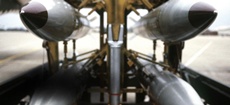Eyeing Russian ‘threats’, US to expand nuclear capability
05 Feb 2018
A policy document released on Friday calls on the United States to expand its nuclear capabilities, in view of Concerns about Russia's growing tactical nuclear weapons.
 Titled the Nuclear Posture Review, it represents the latest sign of hardening resolve by President Donald Trump's administration to address challenges from Russia, at the same time he is pushing for improved ties with Moscow to rein in a nuclear North Korea.
Titled the Nuclear Posture Review, it represents the latest sign of hardening resolve by President Donald Trump's administration to address challenges from Russia, at the same time he is pushing for improved ties with Moscow to rein in a nuclear North Korea.
The document also focuses on China and North Korea, and is said to be in line with the Pentagon shifting priorities from the fight against Islamist militants to "great power competition" with Moscow and Beijing.
"Our strategy will ensure Russia understands that any use of nuclear weapons, however limited, is unacceptable," the review.
The rationale for building up new nuclear capabilities, US officials said, is that Russia currently perceives the United States' nuclear posture and capabilities as inadequate.
''America confronts an international security situation that is more complex and demanding than any since the end of the Cold War. In this environment, it is not possible to delay modernization of our nuclear forces ...,'' the secretary of state's introduction to the document reads.
''For decades, the United States led the world in efforts to reduce the role and number of nuclear weapons. The 1991 Strategic Arms Reduction Treaty (START) set a ceiling of 6,000 accountable strategic nuclear warheads – a deep reduction from Cold War highs. Shorter-range nuclear weapons were almost entirely eliminated from America's nuclear arsenal in the early 1990s. The 2002 Strategic Offensive Reduction Treaty and the 2010 New START Treaty further lowered strategic nuclear force levels to 1,550 accountable warheads.
During this time, the US nuclear weapons stockpile drew down by more than 85 per cent from its Cold War high. Many hoped conditions had been set for even deeper reductions in global nuclear arsenals, and, ultimately, for their elimination.
''While Russia initially followed America's lead and made similarly sharp reductions in its strategic nuclear forces, it retained large numbers of non-strategic nuclear weapons. Today, Russia is modernising these weapons as well as its other strategic systems. Even more troubling has been Russia's adoption of military strategies and capabilities that rely on nuclear escalation for their success. These developments, coupled with Russia's seizure of Crimea and nuclear threats against our allies, mark Moscow's decided return to Great Power competition.
''China, too, is modernising and expanding its already considerable nuclear forces. Like Russia, China is pursuing entirely new nuclear capabilities tailored to achieve particular national security objectives while also modernising its conventional military, challenging traditional US military superiority in the Western Pacific.
''Elsewhere, the strategic picture brings similar concerns. North Korea's nuclear provocations threaten regional and global peace, despite universal condemnation in the United Nations. Iran's nuclear ambitions remain an unresolved concern.
''Globally, nuclear terrorism remains a real danger.
''We must look reality in the eye and see the world as it is, not as we wish it to be. This NPR reflects the current, pragmatic assessment of the threats we face and the uncertainties regarding the future security environment,'' the document says.
Effectiveness, not size
According to The Economist, the document seeks to expand America's nuclear options, but not the overall size of its arsenal.
The review largely confirms the wide-ranging modernisation programme that Barack Obama approved in exchange for Senate ratification of the New START strategic arms-control treaty with Russia. That programme, the Congressional Budget Office estimates, will cost $1.2 trillion over 30 years. It has its critics; the requirement for a new, stealthy air-launched cruise missile has been questioned, for instance.
Russia's foreign ministry said in a statement on Saturday it was very disappointed by the content of the document, which, it said, has a confrontational feel and anti-Russian orientation.
"We, of course, will have to take into account the approach enacted now in Washington and to take the needed measures to secure our own safety," the ministry said.
It denied accusations against Russia made in the US document.
The ministry added that Russia was ready to work constructively with the Americans.
By expanding its own low-yield nuclear capability, the United States would deter Russia from using nuclear weapons, US officials argue.
Low-yield nuclear weapons, while still devastating, have a strength of less than 20 kilotons. The atomic bomb dropped on Hiroshima had about the same explosive power.
The argument for these weapons is that larger nuclear bombs are so catastrophic that they would never be used and do not work as an effective deterrent. With less power and destruction, the low-yield option would potentially be more likely to be used, serving as an effective deterrent.
The Pentagon document, which is largely in line with the previous review in 2010, said the United States will modify a small number of submarine-launched ballistic missile warheads with low-yield options.
In the long term, the US military will also develop a new nuclear-armed sea-launched cruise missile. The missile could have the less powerful option, but a decision has not been made, and will take up to a decade to develop, officials said.
Greg Weaver, deputy director of strategic capabilities at the Pentagon, said the United States would be willing to limit developing the missile if Russia would "redress the imbalance in non-strategic nuclear forces".
Weaver said the most difficult task for those working on the review was trying to address the gap between Russian and American non-strategic nuclear weapons.
Russia has a stockpile of 2,000 non-strategic nuclear weapons, according to the Pentagon. The US has a few hundred active low-yield weapons deployed in Europe.
The US State Department said it had briefed Russian and Chinese officials on the review.






























